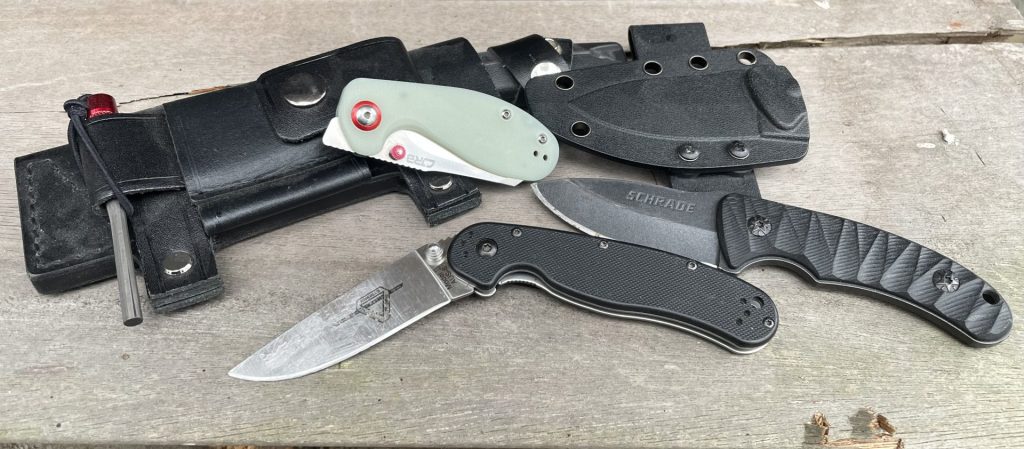
“Fill your bowl to the brim and it will spill. Keep sharpening your knife and it will blunt.” ~Lao Tzu
If you’ve been following along with me, you should have gotten the impression by now that I like to keep things in good working order, especially tools and goods that have inherent quality and are designed to last a long time when properly cared for.
Nowhere is this as evident as in the case of a quality tool like a knife. Knives, the most essential and versatile of all tools, need not even exhibit inherent quality to last a long time when properly cared for. Even a cheap knife will last a long time when it is properly maintained and when its owner does not abuse it.
You may have noticed a similar thread in my relatively recent post on leather boot care. All of your personal belongings and tools need a certain level of care and attention, and a knife is no exception to this maxim.
There are all different sorts of knives, but the insight offered in this post should lend you a good framework for general knife care, regardless of how you use your knife, where you live, or what type of knife you carry.
Keeping Your Knife Sharp
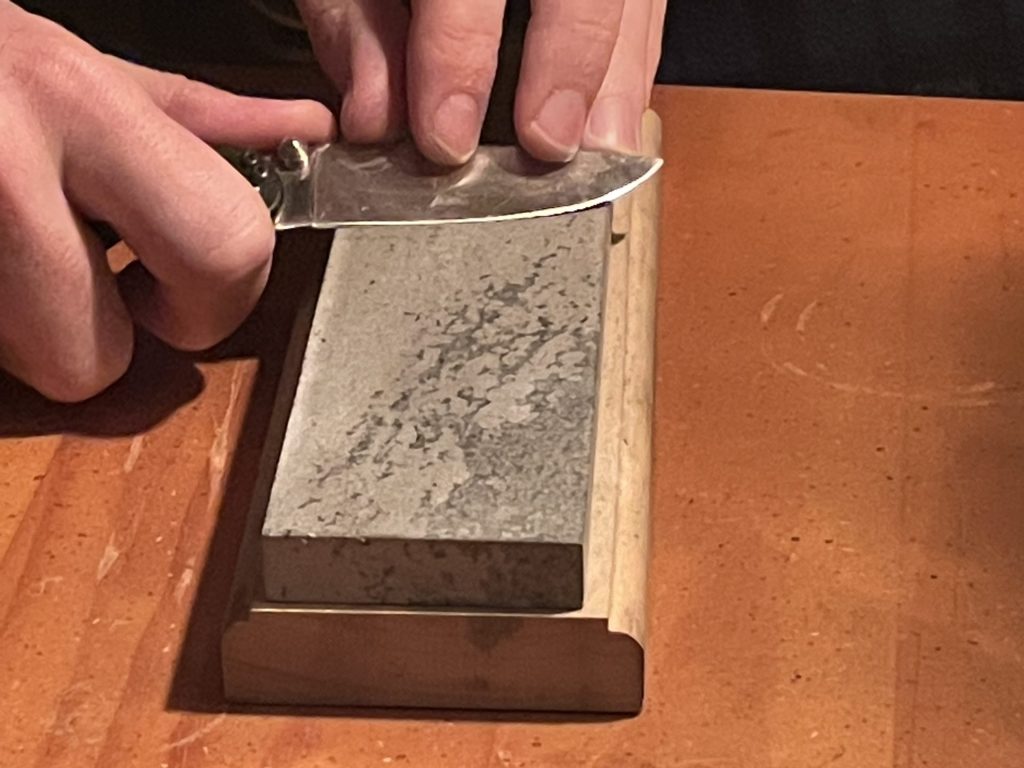
I’m going to lead with this if only because it is the aspect of knife maintenance that is likely most often overlooked. Most every knife care guide will coach you on cleaning, lubricating, storage and protecting against corrosion, and some of them seem to skip right over keeping a knife sharp.
But what does this have to do with maintenance? Well, maintenance is what allows a tool to continue its useful lifespan, right? A knife is not much use when dull and therefore sharpening should be considered a staple element of routine maintenance.
There are practical reasons for this as well as those that are yoked to safety. First, when you’re trying to use a dull knife to cut something – be it paper or wood or food – all you’re going to do is crush it. This is frustrating, to say the very least.
But the truth is that working with a dull knife is inherently dangerous as well. When a knife is dull, you need to compensate for the deficiency of the dull wedge with an undue application of force. That is, you have to strain.
When you strain with a tool, slips, accidents, and sprains are likely. And I can tell you from experience, as have many that have worked with edged tools, that slipping with a knife can have some pretty dangerous and painful consequences.
So, keep a good whetstone handy near your bench or wherever you keep your knives, or a sharpening rod, and learn how to sharpen them. Finish the edge with a strop and get proficient finishing the edge.
Keeping Your Knife Clean

Keeping your knife clean is probably the most important aspect of routine knife care that every knife owner should observe – but just how you need to keep your knife clean will depend on what type of knife it is and how you carry it.
Letting a knife go dirty or just leaving it in a box or pocket after you’ve used it is a quick ticket to blade corrosion, scale damage, pivot or lock wear.
For fixed blade knives, wash them in warm water. If the blade has a protective coating of oil because it’s made with a corrosion-prone steel like 1095 or D2, there’s no need to use soap because that will just strip the oil off; you’ll need to re-oil it if you do this.
Warm water is all you should need to remove most deposits of dirt and grime from the blade. Use this on the scales, too, and again be cautious of soap as it can desiccate and damage natural materials like bone, horn and wood.
For folding knives, use the same method. Rinse the blade off with warm water, then pay particularly close attention to the area between the scales and liner, and around the lock. A gentle stream of warm-hot water is all you’ll need to dislodge most debris.
After you’ve rinsed the knife with warm water, be sure to dry it thoroughly before you store it, as water trapped in the pivot or around the blade when the knife is closed can cause rust. Wipe it off with a rag or paper towel, then leave it open somewhere to dry for a bit before pocketing it again.
Periodically, it may behoove you to entirely disassemble a folding knife for the purpose of administering a deep clean. I have only had to do this a few times and generally avoid doing so as some folding knives and lock types can be particularly tricky to put back together.
To disassemble most folding knives, use an appropriate driver bit to remove the scales (many folders use a Torx bit of some sort) then carefully remove the pivot. Take care when removing the washers and ball-bearing mechanism (where present) as these can often easily be damaged.
Place all screws, washers, and liners aside in a magnetic bowl or somewhere they will not be lost, and pay close attention to the order in which you removed them, since you’ll need to reverse the order to get the knife together again.
With the knife fully disassembled, fill a bowl with warm water and soap and then submerge the blade, scales and liner in this mixture. Gingerly remove any grime or deposits from these components before laying them out on a paper towel to dry.
If the knife’s hardware is particularly oil or dirty, submerge these in the soap bath as well, agitate them to remove the dirt and oil, and then remove them to dry.
Be certain that all components are thoroughly dry before you attempt to reassemble the knife (in the reverse order from which you took it apart). Moreover, give each metal component a light treatment of oil to help prevent corrosion and limber up the works before you reassemble the knife.
Protecting Your Knife Against Corrosion
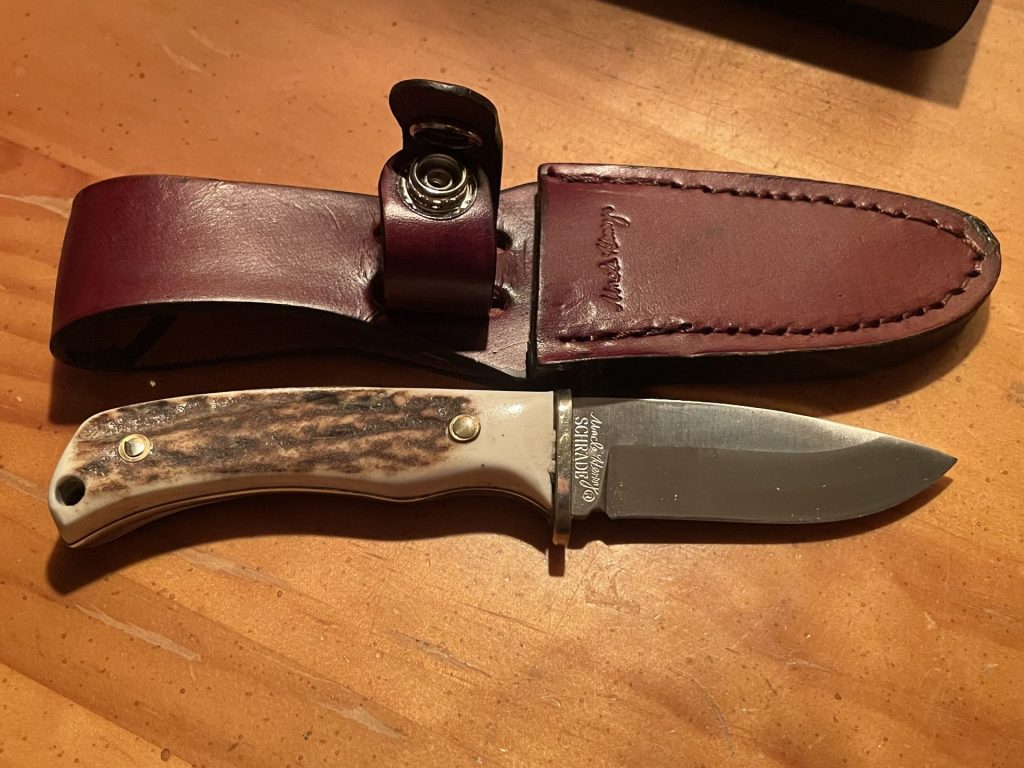
The first, and most important step (for which there is no substitute) for protecting your knife against corrosion is to wash it after use and never to put it away dirty.
This is the most important thing you can do to prevent rust. This being said, there are some alloys that are fairly rust resistant, such as:
420HC
AUS-8, AUS-10
7Cr, 8Cr, and 9Cr MoV
12C28N
440A, 440C
4116
AR-RPM9 (used for example, in the CJRB Maileah)
CPM-20CV
H1
I personally have experience with all of the steels mentioned above with the exception of CPM-20CV and H1, but I have it on good authority that these are fairly resistant to corrosion as well. The steels mentioned above will need very little care, except in the most corrosive environments, in order to buck rust. Simply wipe them clean or give them a good rinse when dirty and then dry them, and that’s all you need.
However, other steels, notably the 10XX (such as 1045 and 1095) as well as tool steels like D2 and 65Mn, are veritable rust magnets. All you need to do is look at these alloys and you’ll see rust starting to bloom before your eyes.
Moreover, I can say from experience that knives made with these steels will rust if you don’t take particularly good care of them.
As stated, your best hedge against rust is simply to keep your knives clean and dry. For stainless alloys, this is generally all you need, but for more rust-prone alloys, you’ll want to apply a thin coat of oil to protect the blade and exposed hardware.
For fixed knives, simply apply a drop or two of oil to the blade, or to a rag, and then use that to (carefully) coat the blade. If you use your knife for food prep, make sure you use a food-safe oil. For my knives, many of which are not used for food prep, I sometimes prefer Rem Oil, as it is long lasting, heat-stable, and provides excellent protection against oxidative stress.
For folding knives, you need to be a bit more ginger when it comes to protecting against corrosion. All of the same rules I mentioned still apply, but with folding knives, you have a moving action you need to think about.
You don’t need to exhibit too much caution when you’re oiling the blade of a folding knife, but when it comes to getting oil in the action (see below) you’re going to want to be cautious because oiling too liberally will give dirt and dust a place to adhere (unsurprisingly, dirt and dust stick to oil).
Protecting and Maintaining Natural Scales
I added this section in as I was writing because it occurred to me that some knives are made with natural materials that need a little extra care. I even have some knives with antler, bone, wood and leather handles or scales. These need specific care and attention.
If you have a knife with nylon, G10, steel, titanium, aluminum, or even carbon fiber scales, have at it. Wash them with hot water, use soap to clean them. Or just don’t clean them at all. They’ll probably be fine, and all of these materials listed are impervious to corrosion (except steel scales, which are typically made from stainless alloys, anyway).
Anyway, wood, horn, antler, bone, leather, and other natural scales and handles will be damaged by soap, hot water, and harsh detergents.
If your knife features stacked leather handles, as some old Ontario knives do, simply brush them clean and apply a little bit of neatsfoot oil or a special leather conditioner. This will help protect them from water damage and from drying out and cracking.
You can use a damp warm rag on stacked leather handles, but do not submerge them in water or use soap or detergents. This will exacerbate the drying in leather and can cause cracking and premature degradation.
Horn, bone and wood are all likewise susceptible to desiccation but they are not quite as fragile as leather. These materials, however, can also be damaged by very hot water and harsh detergents. When cleaning a horn, bone or wood handle, wipe it clean with a warm, damp rag, preferably without soap.
Since neatsfoot oil is actually squeezed from the shin bones of cattle, you can use them to treat antler and bone if they are dry and cracking. Don’t apply too much though. I’ve read some guides that suggested submerging a bone handle in mineral oil, but I advise against it, since mineral oil can exacerbate drying in the long run (just like it can on your skin).
As for wood, use a warm damp rag on it to wipe it clean as well, and then apply a wood treatment or conditioner. Conditioners that contain beeswax and tung oil or linseed oil will protect wood and prevent it from drying out and cracking, but just like on bone or antler, apply them scantly. You don’t want the wood to swell too much with oil and wax, and you can’t get it out once you apply it.
For Folding Knives: Lubricating the Action
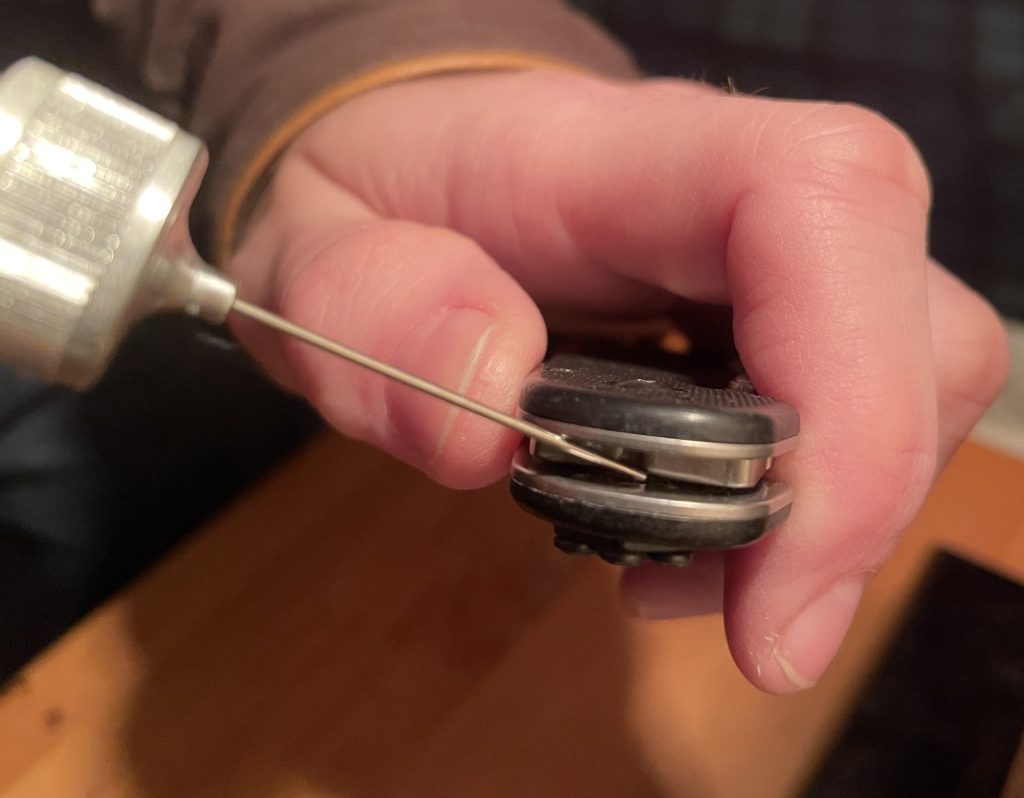
Now let’s talk about cleaning and lubricating the action of a folding knife. Cleaning and lubrication are necessary from time to time, because lint and dust will get into the action of a knife and can cause abrasive damage if left there for too long.
However, fight the urge to rinse it out with water or slather it with oil. Your best protection for your knife’s action actually comes in the form of compressed air.
This is one of the best kept secrets that I’ve come across. Keeping a can of compressed air handy is the perfect solution for blasting lint and dust out from in between the scales of your folding knife.
The best part: compressed air is not corrosive and it needs no time to dry. If you run your knife under water, you need to be fastidious about drying it out or you and seize the action from rust. Moreover, compressed air will neither attract nor trap dust and particulate matter in or near the action.
Now, some might advise you to just skip this part and limber up the pivot with a drop of oil or two, but if you don’t clear it out first, all you’re going to do is trap the dust there. Really, if your knife is very dirty, you’ll want to take the scales off and the pivot apart, clean them all, dry them, replace them in reverse order, and then apply a drop of oil.
But, apply only one or two at most. Less oil is better. The less you need to use, the less you will create a sticky magnet for dirt and other nonesuch from gumming up the action.
That little bit of oil is all you need to lubricate the pivot and will be plenty to protect your knife’s action against corrosion without excessively attracting dirt.
Tightening Up the Works
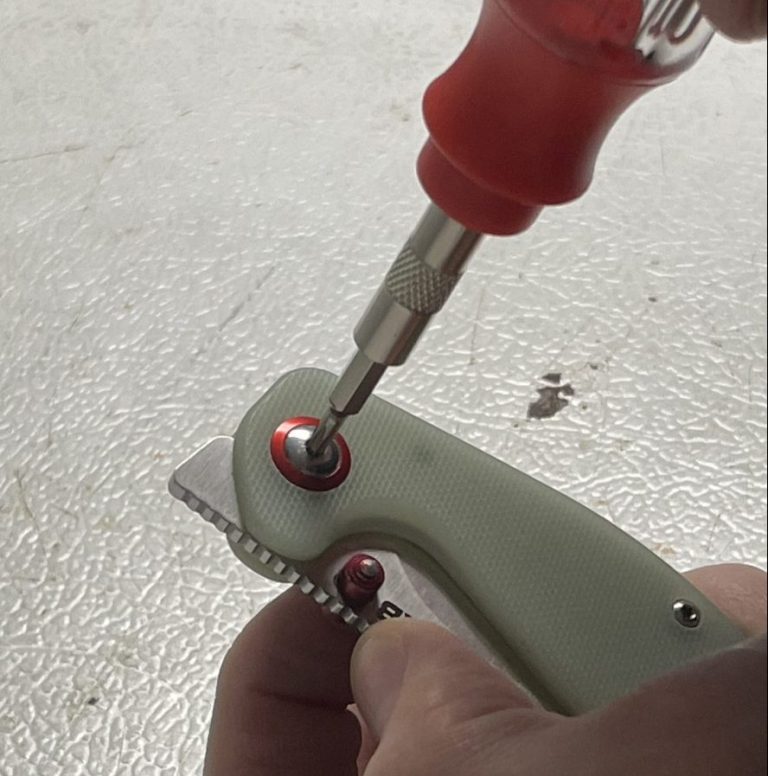
Another note to the wise, especially for those of you that carry a folding knife, though this is basically inapplicable to fixed blades.
Depending on your knife’s action and how the pivot is secured, it will probably work loose over time. I’ve had knives that, within a few months of use, developed noticeable play in the action that allowed the knife blade to wiggle a little bit from side to side, even when locked open.
This happens because, with use and (to a greater degree, abuse) the pivot screw can come slightly loose. Every time you open the blade, it can loosen the screw a little bit.
The solution is easy. Just keep a screwdriver with an appropriate bit (most pivot screws are some size of Torx bit) and give it a half turn or two from time to time, or whenever a bit of play starts to become evident in the blade.
By the way, this is not just a matter of handling and ergonomics. Keeping your pivot tight helps prevent dust and dirt from getting inside and clogging the action, which can also cause abrasive damage.
Storing Your Knife When Not in Use
The manner in which you store your knife when not in use is every ounce as important as the level of assiduity you observe in keeping it clean. Improper storage can destroy some knives.
If you keep your knife clean and dry, you can probably store it however you like. However, some generally good practices to observe are as follows: store your knife someone clean, cool, and dry, out of direct sunlight.
If your knife has a blade that’s prone to corrosion and it has a leather sheath, do not store it in a leather sheath. In fact, good practice is not to store any knife in a leather sheath. No steel is corrosion proof, and a leather sheath will always trap a little bit of moisture.
I’ve had knives with relatively corrosion proof steels (420HC, notably) start to develop little spots of rust when stored in leather sheaths for a few months.
So, learn from my mistakes, and don’t keep your knife in them. Instead, store it separate from and alongside its sheath, somewhere cool and dry.
What You Should Not Do with Your Knife
Since this article is about knife care, it seems only proper to expend a few words on things you should not do with your knife, since proper knife ownership extends to use and not just to maintenance.
Never throw your knives unless they are specifically designed for throwing. Most knives are tempered with a heat treatment that’s designed for edge retention. That is, they are harder. Hard steel has poor resistance to high impulse, which is exactly what you’ll be subjecting your knives to when you throw them. Fixed blades are liable to break, folding knives are likely to experience lock failure. I wouldn’t if I were you.
Do not, under any circumstances, baton with a folding knife. I’ve yet to encounter a folding knife lock that’s robust enough to stand up to batoning. You’re going to break the lock. If you’ve had a different experience, by all means, let me know in the comments.
Do not store your knife wet, especially if you were using it in the presence of saltwater. That is a quick way to lose it to rust in a matter of days. I’ve ruined several cheap bait knives this way, before I learned my lesson.

Do not chop with a folding knife.
Do not pry with a folding knife, you will stress the lock and may break it. Actually, bet practices are not to pry with any knife, but you can use your discretion with fixed blades. Just don’t say I said it was acceptable; you may break your knife doing so.
Do not store your knife in leather sheath for a prolonged period of time. As I have already belabored, it will rust.
Never wash your knives in the dishwasher. Not that I ever have, but I keep seeing this tip on “knife care posts” and I can’t believe I even need to write this .Dishwashers get way too hot and use harsh detergents that will damage your knives. Not to mention, if your knife is made with a steel alloy that is not resistant to corrosion, the drying cycle will probably rust it.
Don’t use your knife as a hammer or a striking tool. You may be able to get away with it, but you run an unreasonable risk of damaging your knife. If you need a striking implement, use the poll of a hatchet, or better yet, use your knife to make a maul.
Knife Care 101: Your Honorary Knife Care Diploma
That’s about all I can think of in terms of how to care for most knives (without getting too much into the details on specifics of a specific knife, steel, or action type) as well as what you shouldn’t do with them.
Hopefully you learned a thing or two, and by all means, don’t let my post supplant your good judgment. If it doesn’t seem like a good idea, it probably isn’t!
Keep your knives sharp, and be safe.
~The Eclectic Outfitter.